Digital Transformation and Customer Impact: McDonald's Analysis
VerifiedAdded on 2020/06/04
|28
|7069
|43
Report
AI Summary
This report presents an analysis of McDonald's digital transformation, exploring its various stages, including business as usual, present and active, formalized, strategic, converged, and innovative and adaptive approaches. The research investigates the benefits of digital transformation, such as improved customer acquisition, extended global reach, and increased sales, while also acknowledging the challenges associated with implementation, including employee training, cost of technology, and data privacy. The study further examines the impact of digital transformation on McDonald's customers, highlighting the use of mobile applications for ordering, discounts, and offers. The research employs a descriptive research design and positivism philosophy to analyze the influence of digital technology on McDonald's business objectives. The report's findings and recommendations aim to enhance McDonald's competitiveness and customer satisfaction through strategic digital initiatives.
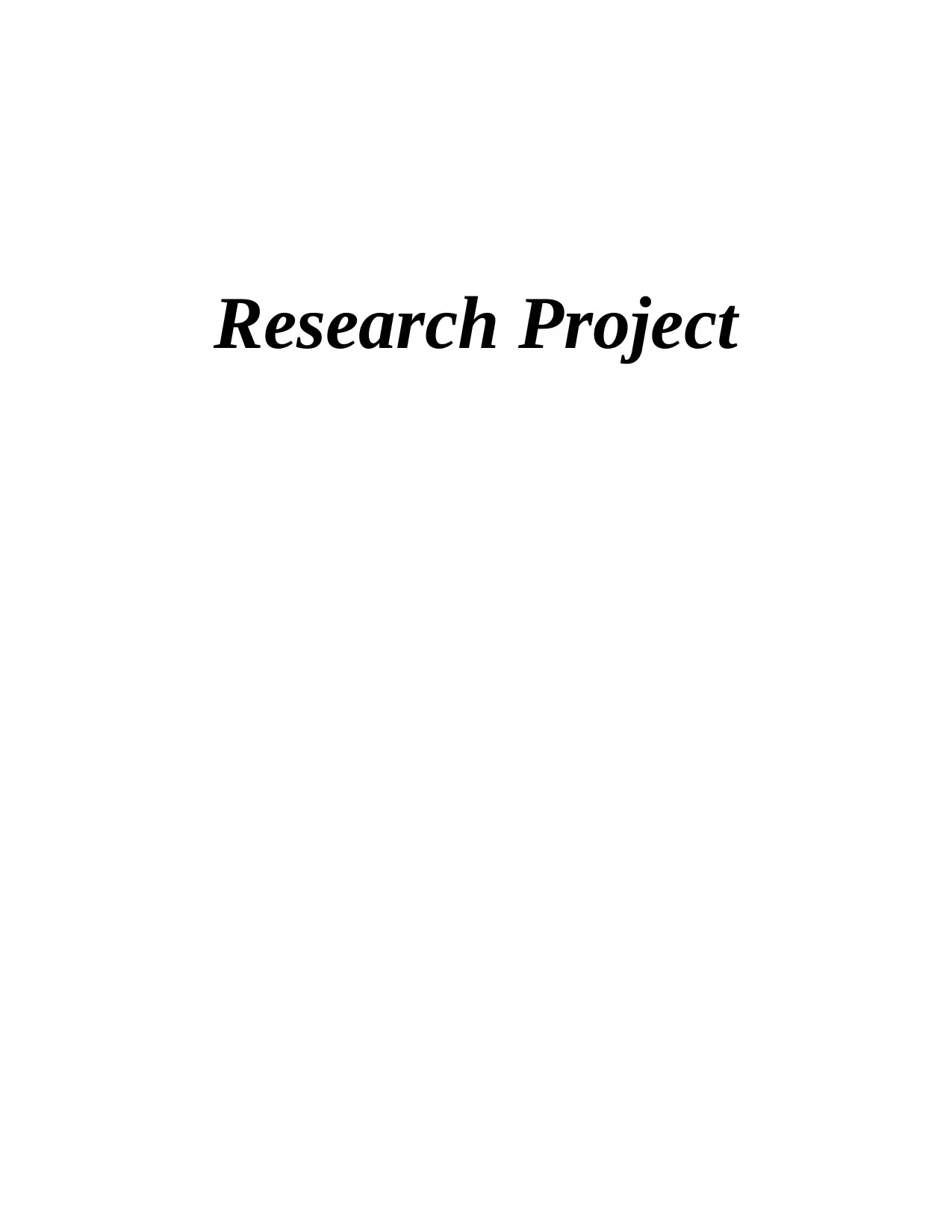
Research Project
Paraphrase This Document
Need a fresh take? Get an instant paraphrase of this document with our AI Paraphraser
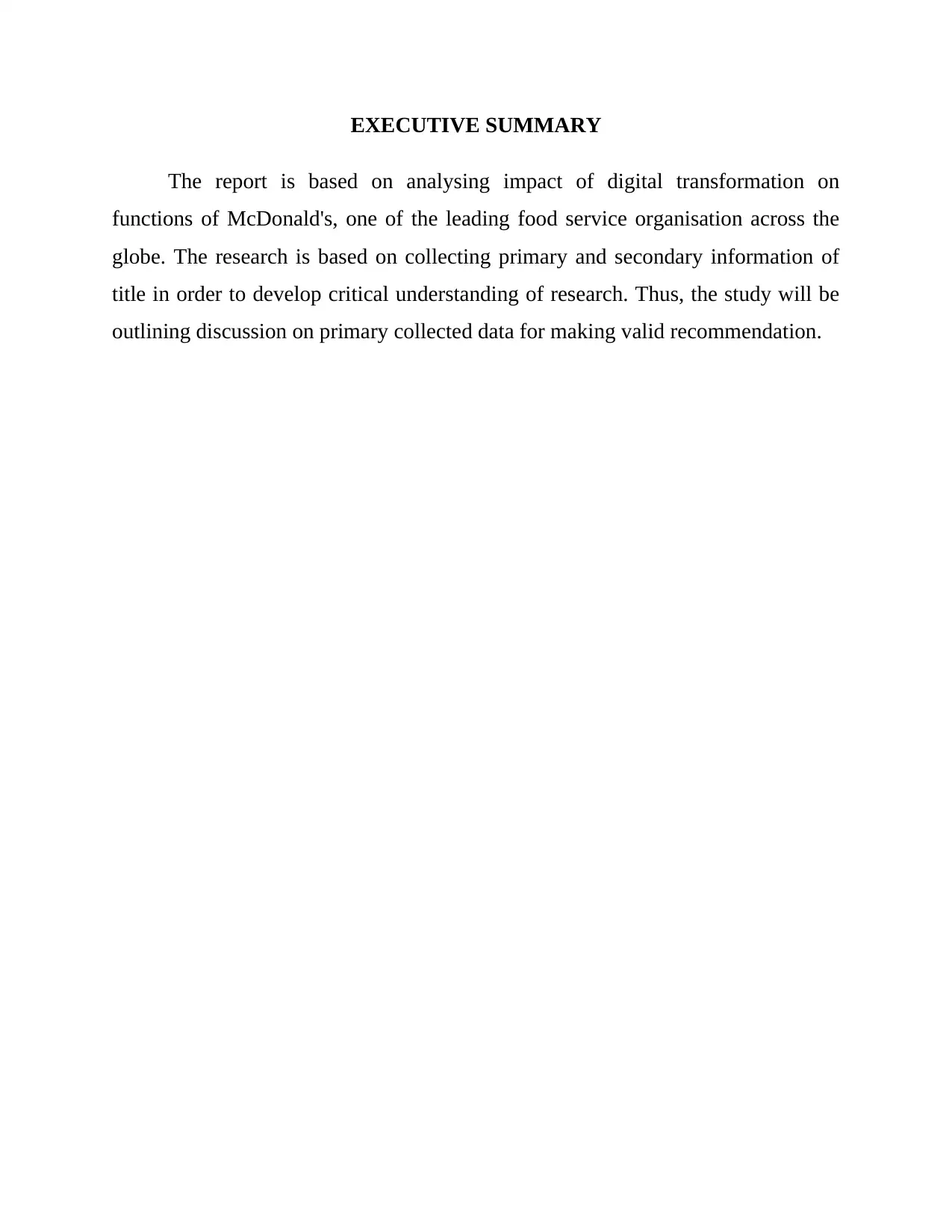
EXECUTIVE SUMMARY
The report is based on analysing impact of digital transformation on
functions of McDonald's, one of the leading food service organisation across the
globe. The research is based on collecting primary and secondary information of
title in order to develop critical understanding of research. Thus, the study will be
outlining discussion on primary collected data for making valid recommendation.
The report is based on analysing impact of digital transformation on
functions of McDonald's, one of the leading food service organisation across the
globe. The research is based on collecting primary and secondary information of
title in order to develop critical understanding of research. Thus, the study will be
outlining discussion on primary collected data for making valid recommendation.
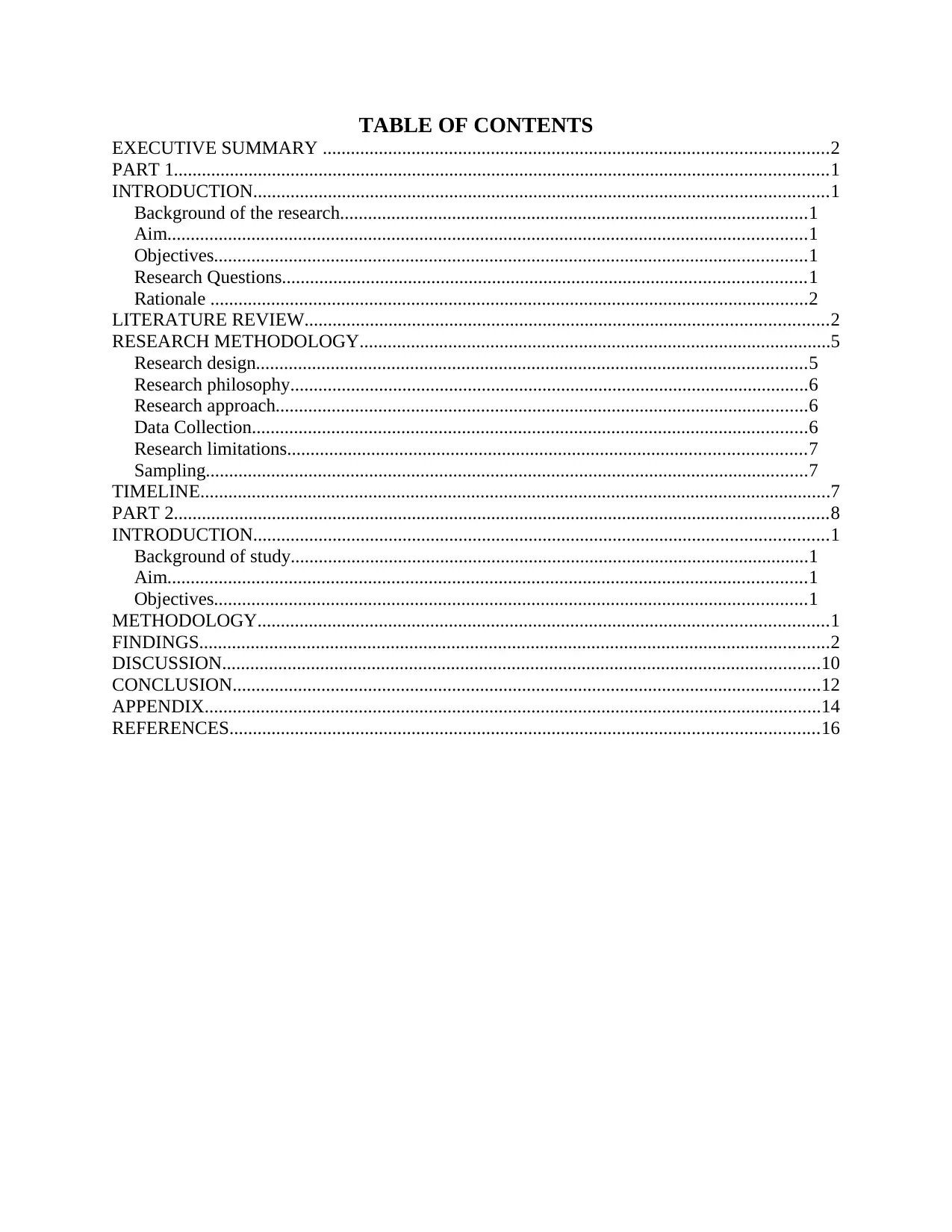
TABLE OF CONTENTS
EXECUTIVE SUMMARY ............................................................................................................2
PART 1............................................................................................................................................1
INTRODUCTION...........................................................................................................................1
Background of the research....................................................................................................1
Aim.........................................................................................................................................1
Objectives...............................................................................................................................1
Research Questions................................................................................................................1
Rationale ................................................................................................................................2
LITERATURE REVIEW................................................................................................................2
RESEARCH METHODOLOGY.....................................................................................................5
Research design......................................................................................................................5
Research philosophy...............................................................................................................6
Research approach..................................................................................................................6
Data Collection.......................................................................................................................6
Research limitations...............................................................................................................7
Sampling.................................................................................................................................7
TIMELINE.......................................................................................................................................7
PART 2............................................................................................................................................8
INTRODUCTION...........................................................................................................................1
Background of study...............................................................................................................1
Aim.........................................................................................................................................1
Objectives...............................................................................................................................1
METHODOLOGY..........................................................................................................................1
FINDINGS.......................................................................................................................................2
DISCUSSION................................................................................................................................10
CONCLUSION..............................................................................................................................12
APPENDIX....................................................................................................................................14
REFERENCES..............................................................................................................................16
EXECUTIVE SUMMARY ............................................................................................................2
PART 1............................................................................................................................................1
INTRODUCTION...........................................................................................................................1
Background of the research....................................................................................................1
Aim.........................................................................................................................................1
Objectives...............................................................................................................................1
Research Questions................................................................................................................1
Rationale ................................................................................................................................2
LITERATURE REVIEW................................................................................................................2
RESEARCH METHODOLOGY.....................................................................................................5
Research design......................................................................................................................5
Research philosophy...............................................................................................................6
Research approach..................................................................................................................6
Data Collection.......................................................................................................................6
Research limitations...............................................................................................................7
Sampling.................................................................................................................................7
TIMELINE.......................................................................................................................................7
PART 2............................................................................................................................................8
INTRODUCTION...........................................................................................................................1
Background of study...............................................................................................................1
Aim.........................................................................................................................................1
Objectives...............................................................................................................................1
METHODOLOGY..........................................................................................................................1
FINDINGS.......................................................................................................................................2
DISCUSSION................................................................................................................................10
CONCLUSION..............................................................................................................................12
APPENDIX....................................................................................................................................14
REFERENCES..............................................................................................................................16
⊘ This is a preview!⊘
Do you want full access?
Subscribe today to unlock all pages.

Trusted by 1+ million students worldwide
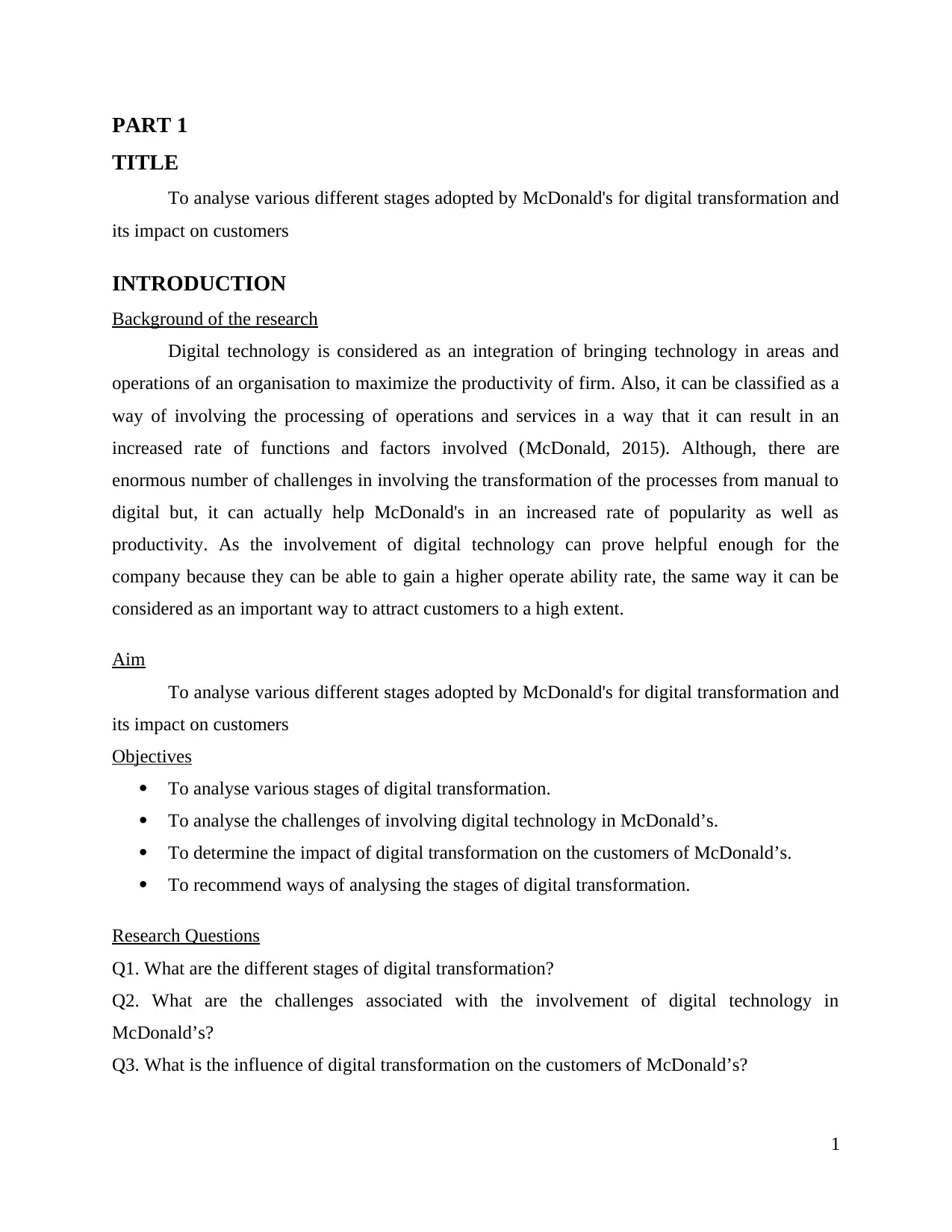
PART 1
TITLE
To analyse various different stages adopted by McDonald's for digital transformation and
its impact on customers
INTRODUCTION
Background of the research
Digital technology is considered as an integration of bringing technology in areas and
operations of an organisation to maximize the productivity of firm. Also, it can be classified as a
way of involving the processing of operations and services in a way that it can result in an
increased rate of functions and factors involved (McDonald, 2015). Although, there are
enormous number of challenges in involving the transformation of the processes from manual to
digital but, it can actually help McDonald's in an increased rate of popularity as well as
productivity. As the involvement of digital technology can prove helpful enough for the
company because they can be able to gain a higher operate ability rate, the same way it can be
considered as an important way to attract customers to a high extent.
Aim
To analyse various different stages adopted by McDonald's for digital transformation and
its impact on customers
Objectives
To analyse various stages of digital transformation.
To analyse the challenges of involving digital technology in McDonald’s.
To determine the impact of digital transformation on the customers of McDonald’s.
To recommend ways of analysing the stages of digital transformation.
Research Questions
Q1. What are the different stages of digital transformation?
Q2. What are the challenges associated with the involvement of digital technology in
McDonald’s?
Q3. What is the influence of digital transformation on the customers of McDonald’s?
1
TITLE
To analyse various different stages adopted by McDonald's for digital transformation and
its impact on customers
INTRODUCTION
Background of the research
Digital technology is considered as an integration of bringing technology in areas and
operations of an organisation to maximize the productivity of firm. Also, it can be classified as a
way of involving the processing of operations and services in a way that it can result in an
increased rate of functions and factors involved (McDonald, 2015). Although, there are
enormous number of challenges in involving the transformation of the processes from manual to
digital but, it can actually help McDonald's in an increased rate of popularity as well as
productivity. As the involvement of digital technology can prove helpful enough for the
company because they can be able to gain a higher operate ability rate, the same way it can be
considered as an important way to attract customers to a high extent.
Aim
To analyse various different stages adopted by McDonald's for digital transformation and
its impact on customers
Objectives
To analyse various stages of digital transformation.
To analyse the challenges of involving digital technology in McDonald’s.
To determine the impact of digital transformation on the customers of McDonald’s.
To recommend ways of analysing the stages of digital transformation.
Research Questions
Q1. What are the different stages of digital transformation?
Q2. What are the challenges associated with the involvement of digital technology in
McDonald’s?
Q3. What is the influence of digital transformation on the customers of McDonald’s?
1
Paraphrase This Document
Need a fresh take? Get an instant paraphrase of this document with our AI Paraphraser
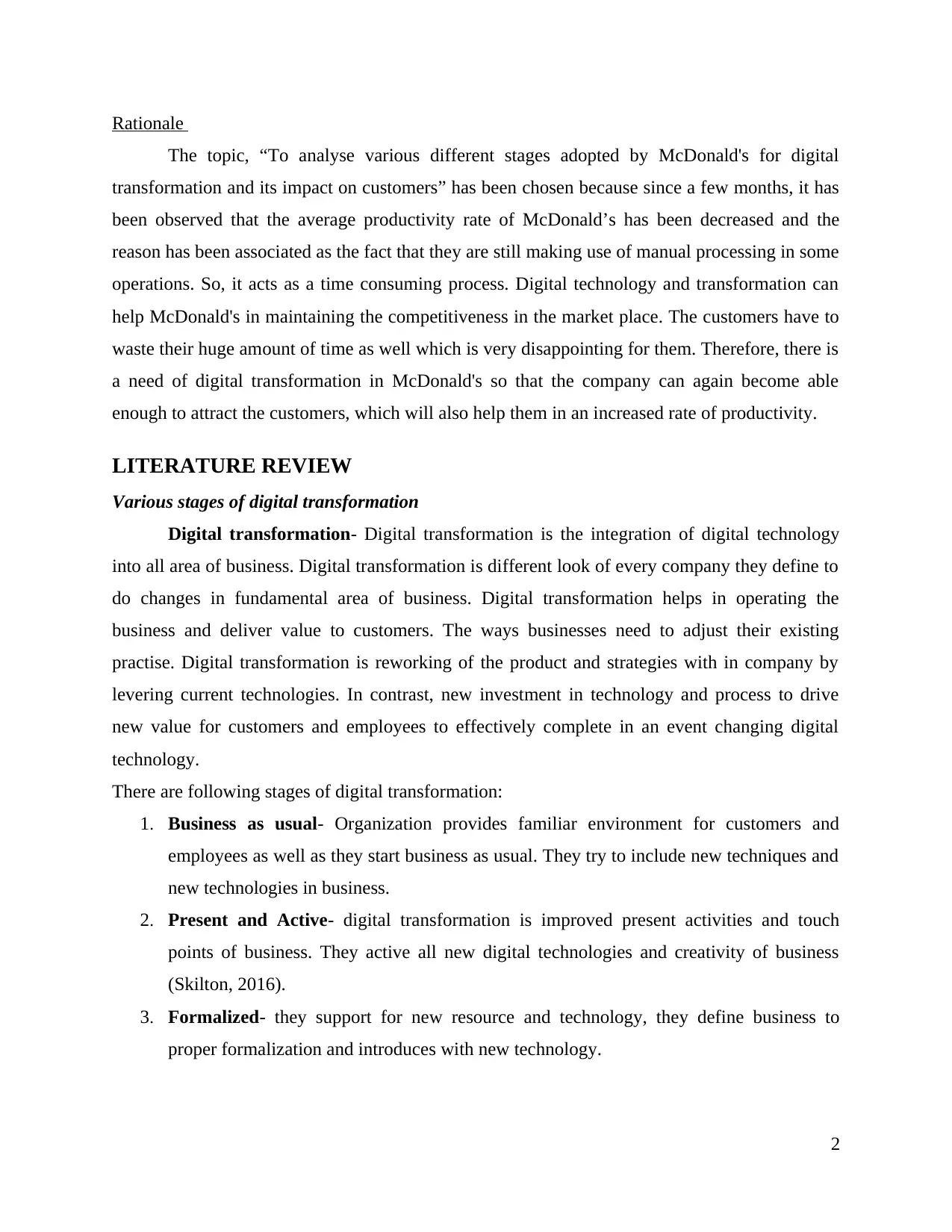
Rationale
The topic, “To analyse various different stages adopted by McDonald's for digital
transformation and its impact on customers” has been chosen because since a few months, it has
been observed that the average productivity rate of McDonald’s has been decreased and the
reason has been associated as the fact that they are still making use of manual processing in some
operations. So, it acts as a time consuming process. Digital technology and transformation can
help McDonald's in maintaining the competitiveness in the market place. The customers have to
waste their huge amount of time as well which is very disappointing for them. Therefore, there is
a need of digital transformation in McDonald's so that the company can again become able
enough to attract the customers, which will also help them in an increased rate of productivity.
LITERATURE REVIEW
Various stages of digital transformation
Digital transformation- Digital transformation is the integration of digital technology
into all area of business. Digital transformation is different look of every company they define to
do changes in fundamental area of business. Digital transformation helps in operating the
business and deliver value to customers. The ways businesses need to adjust their existing
practise. Digital transformation is reworking of the product and strategies with in company by
levering current technologies. In contrast, new investment in technology and process to drive
new value for customers and employees to effectively complete in an event changing digital
technology.
There are following stages of digital transformation:
1. Business as usual- Organization provides familiar environment for customers and
employees as well as they start business as usual. They try to include new techniques and
new technologies in business.
2. Present and Active- digital transformation is improved present activities and touch
points of business. They active all new digital technologies and creativity of business
(Skilton, 2016).
3. Formalized- they support for new resource and technology, they define business to
proper formalization and introduces with new technology.
2
The topic, “To analyse various different stages adopted by McDonald's for digital
transformation and its impact on customers” has been chosen because since a few months, it has
been observed that the average productivity rate of McDonald’s has been decreased and the
reason has been associated as the fact that they are still making use of manual processing in some
operations. So, it acts as a time consuming process. Digital technology and transformation can
help McDonald's in maintaining the competitiveness in the market place. The customers have to
waste their huge amount of time as well which is very disappointing for them. Therefore, there is
a need of digital transformation in McDonald's so that the company can again become able
enough to attract the customers, which will also help them in an increased rate of productivity.
LITERATURE REVIEW
Various stages of digital transformation
Digital transformation- Digital transformation is the integration of digital technology
into all area of business. Digital transformation is different look of every company they define to
do changes in fundamental area of business. Digital transformation helps in operating the
business and deliver value to customers. The ways businesses need to adjust their existing
practise. Digital transformation is reworking of the product and strategies with in company by
levering current technologies. In contrast, new investment in technology and process to drive
new value for customers and employees to effectively complete in an event changing digital
technology.
There are following stages of digital transformation:
1. Business as usual- Organization provides familiar environment for customers and
employees as well as they start business as usual. They try to include new techniques and
new technologies in business.
2. Present and Active- digital transformation is improved present activities and touch
points of business. They active all new digital technologies and creativity of business
(Skilton, 2016).
3. Formalized- they support for new resource and technology, they define business to
proper formalization and introduces with new technology.
2
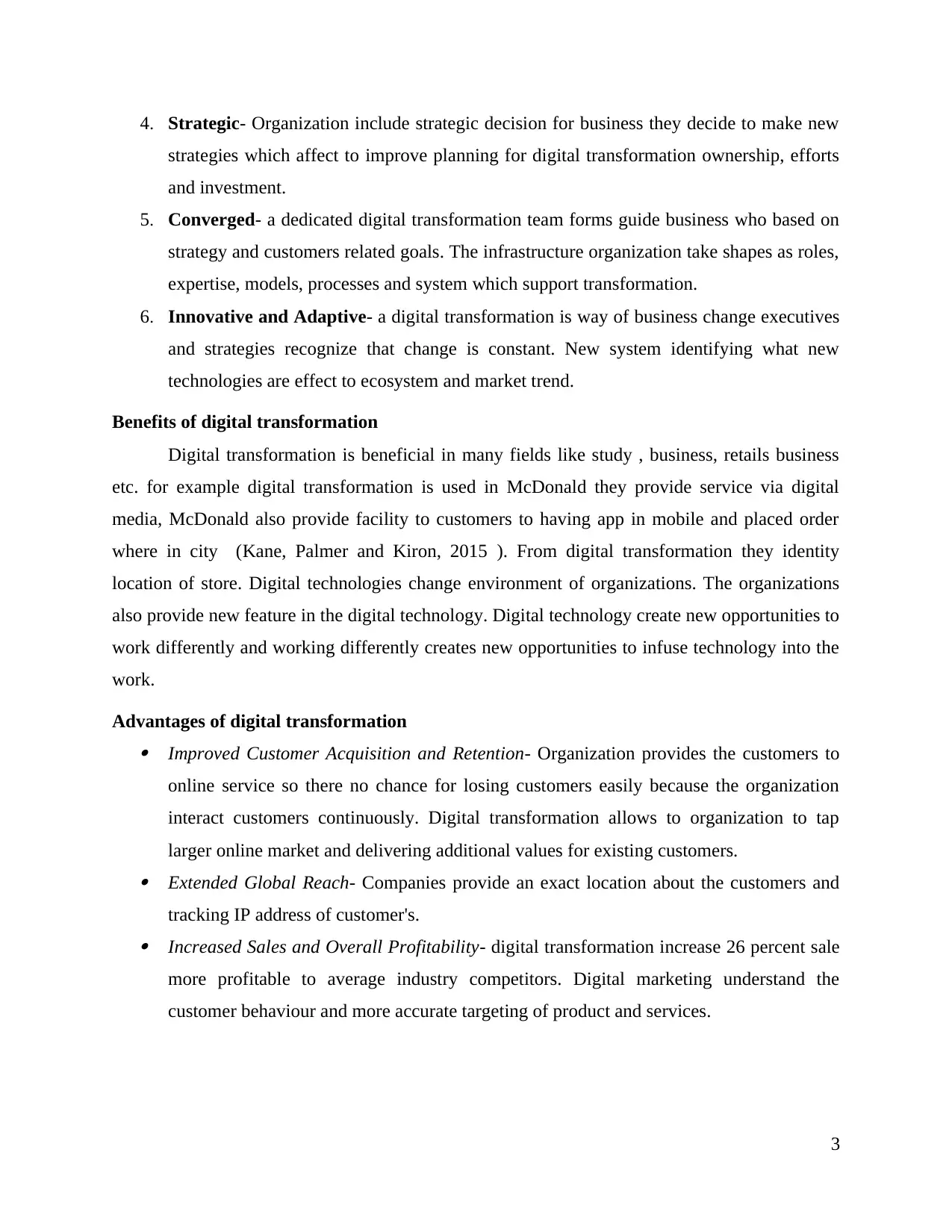
4. Strategic- Organization include strategic decision for business they decide to make new
strategies which affect to improve planning for digital transformation ownership, efforts
and investment.
5. Converged- a dedicated digital transformation team forms guide business who based on
strategy and customers related goals. The infrastructure organization take shapes as roles,
expertise, models, processes and system which support transformation.
6. Innovative and Adaptive- a digital transformation is way of business change executives
and strategies recognize that change is constant. New system identifying what new
technologies are effect to ecosystem and market trend.
Benefits of digital transformation
Digital transformation is beneficial in many fields like study , business, retails business
etc. for example digital transformation is used in McDonald they provide service via digital
media, McDonald also provide facility to customers to having app in mobile and placed order
where in city (Kane, Palmer and Kiron, 2015 ). From digital transformation they identity
location of store. Digital technologies change environment of organizations. The organizations
also provide new feature in the digital technology. Digital technology create new opportunities to
work differently and working differently creates new opportunities to infuse technology into the
work.
Advantages of digital transformation Improved Customer Acquisition and Retention- Organization provides the customers to
online service so there no chance for losing customers easily because the organization
interact customers continuously. Digital transformation allows to organization to tap
larger online market and delivering additional values for existing customers. Extended Global Reach- Companies provide an exact location about the customers and
tracking IP address of customer's. Increased Sales and Overall Profitability- digital transformation increase 26 percent sale
more profitable to average industry competitors. Digital marketing understand the
customer behaviour and more accurate targeting of product and services.
3
strategies which affect to improve planning for digital transformation ownership, efforts
and investment.
5. Converged- a dedicated digital transformation team forms guide business who based on
strategy and customers related goals. The infrastructure organization take shapes as roles,
expertise, models, processes and system which support transformation.
6. Innovative and Adaptive- a digital transformation is way of business change executives
and strategies recognize that change is constant. New system identifying what new
technologies are effect to ecosystem and market trend.
Benefits of digital transformation
Digital transformation is beneficial in many fields like study , business, retails business
etc. for example digital transformation is used in McDonald they provide service via digital
media, McDonald also provide facility to customers to having app in mobile and placed order
where in city (Kane, Palmer and Kiron, 2015 ). From digital transformation they identity
location of store. Digital technologies change environment of organizations. The organizations
also provide new feature in the digital technology. Digital technology create new opportunities to
work differently and working differently creates new opportunities to infuse technology into the
work.
Advantages of digital transformation Improved Customer Acquisition and Retention- Organization provides the customers to
online service so there no chance for losing customers easily because the organization
interact customers continuously. Digital transformation allows to organization to tap
larger online market and delivering additional values for existing customers. Extended Global Reach- Companies provide an exact location about the customers and
tracking IP address of customer's. Increased Sales and Overall Profitability- digital transformation increase 26 percent sale
more profitable to average industry competitors. Digital marketing understand the
customer behaviour and more accurate targeting of product and services.
3
⊘ This is a preview!⊘
Do you want full access?
Subscribe today to unlock all pages.

Trusted by 1+ million students worldwide
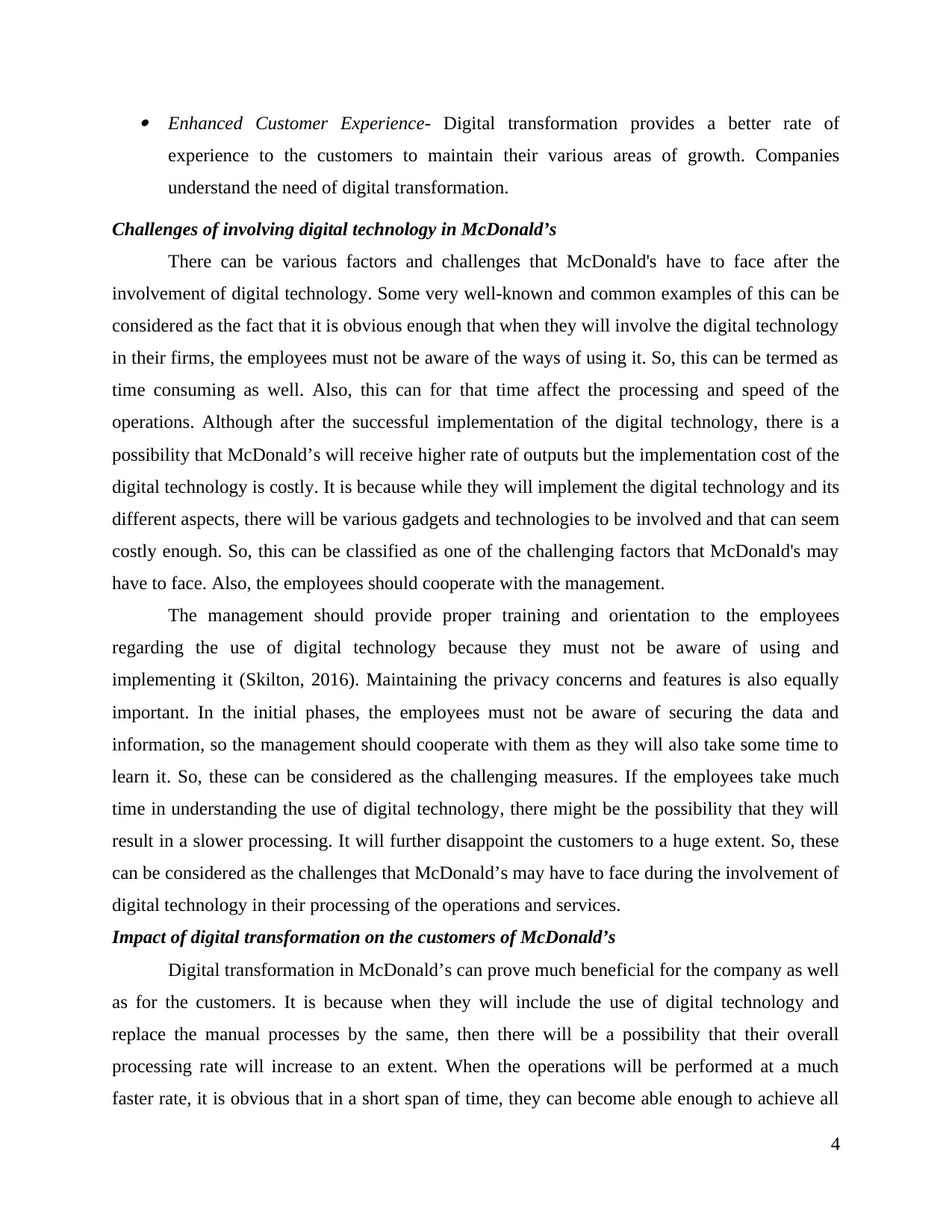
Enhanced Customer Experience- Digital transformation provides a better rate of
experience to the customers to maintain their various areas of growth. Companies
understand the need of digital transformation.
Challenges of involving digital technology in McDonald’s
There can be various factors and challenges that McDonald's have to face after the
involvement of digital technology. Some very well-known and common examples of this can be
considered as the fact that it is obvious enough that when they will involve the digital technology
in their firms, the employees must not be aware of the ways of using it. So, this can be termed as
time consuming as well. Also, this can for that time affect the processing and speed of the
operations. Although after the successful implementation of the digital technology, there is a
possibility that McDonald’s will receive higher rate of outputs but the implementation cost of the
digital technology is costly. It is because while they will implement the digital technology and its
different aspects, there will be various gadgets and technologies to be involved and that can seem
costly enough. So, this can be classified as one of the challenging factors that McDonald's may
have to face. Also, the employees should cooperate with the management.
The management should provide proper training and orientation to the employees
regarding the use of digital technology because they must not be aware of using and
implementing it (Skilton, 2016). Maintaining the privacy concerns and features is also equally
important. In the initial phases, the employees must not be aware of securing the data and
information, so the management should cooperate with them as they will also take some time to
learn it. So, these can be considered as the challenging measures. If the employees take much
time in understanding the use of digital technology, there might be the possibility that they will
result in a slower processing. It will further disappoint the customers to a huge extent. So, these
can be considered as the challenges that McDonald’s may have to face during the involvement of
digital technology in their processing of the operations and services.
Impact of digital transformation on the customers of McDonald’s
Digital transformation in McDonald’s can prove much beneficial for the company as well
as for the customers. It is because when they will include the use of digital technology and
replace the manual processes by the same, then there will be a possibility that their overall
processing rate will increase to an extent. When the operations will be performed at a much
faster rate, it is obvious that in a short span of time, they can become able enough to achieve all
4
experience to the customers to maintain their various areas of growth. Companies
understand the need of digital transformation.
Challenges of involving digital technology in McDonald’s
There can be various factors and challenges that McDonald's have to face after the
involvement of digital technology. Some very well-known and common examples of this can be
considered as the fact that it is obvious enough that when they will involve the digital technology
in their firms, the employees must not be aware of the ways of using it. So, this can be termed as
time consuming as well. Also, this can for that time affect the processing and speed of the
operations. Although after the successful implementation of the digital technology, there is a
possibility that McDonald’s will receive higher rate of outputs but the implementation cost of the
digital technology is costly. It is because while they will implement the digital technology and its
different aspects, there will be various gadgets and technologies to be involved and that can seem
costly enough. So, this can be classified as one of the challenging factors that McDonald's may
have to face. Also, the employees should cooperate with the management.
The management should provide proper training and orientation to the employees
regarding the use of digital technology because they must not be aware of using and
implementing it (Skilton, 2016). Maintaining the privacy concerns and features is also equally
important. In the initial phases, the employees must not be aware of securing the data and
information, so the management should cooperate with them as they will also take some time to
learn it. So, these can be considered as the challenging measures. If the employees take much
time in understanding the use of digital technology, there might be the possibility that they will
result in a slower processing. It will further disappoint the customers to a huge extent. So, these
can be considered as the challenges that McDonald’s may have to face during the involvement of
digital technology in their processing of the operations and services.
Impact of digital transformation on the customers of McDonald’s
Digital transformation in McDonald’s can prove much beneficial for the company as well
as for the customers. It is because when they will include the use of digital technology and
replace the manual processes by the same, then there will be a possibility that their overall
processing rate will increase to an extent. When the operations will be performed at a much
faster rate, it is obvious that in a short span of time, they can become able enough to achieve all
4
Paraphrase This Document
Need a fresh take? Get an instant paraphrase of this document with our AI Paraphraser
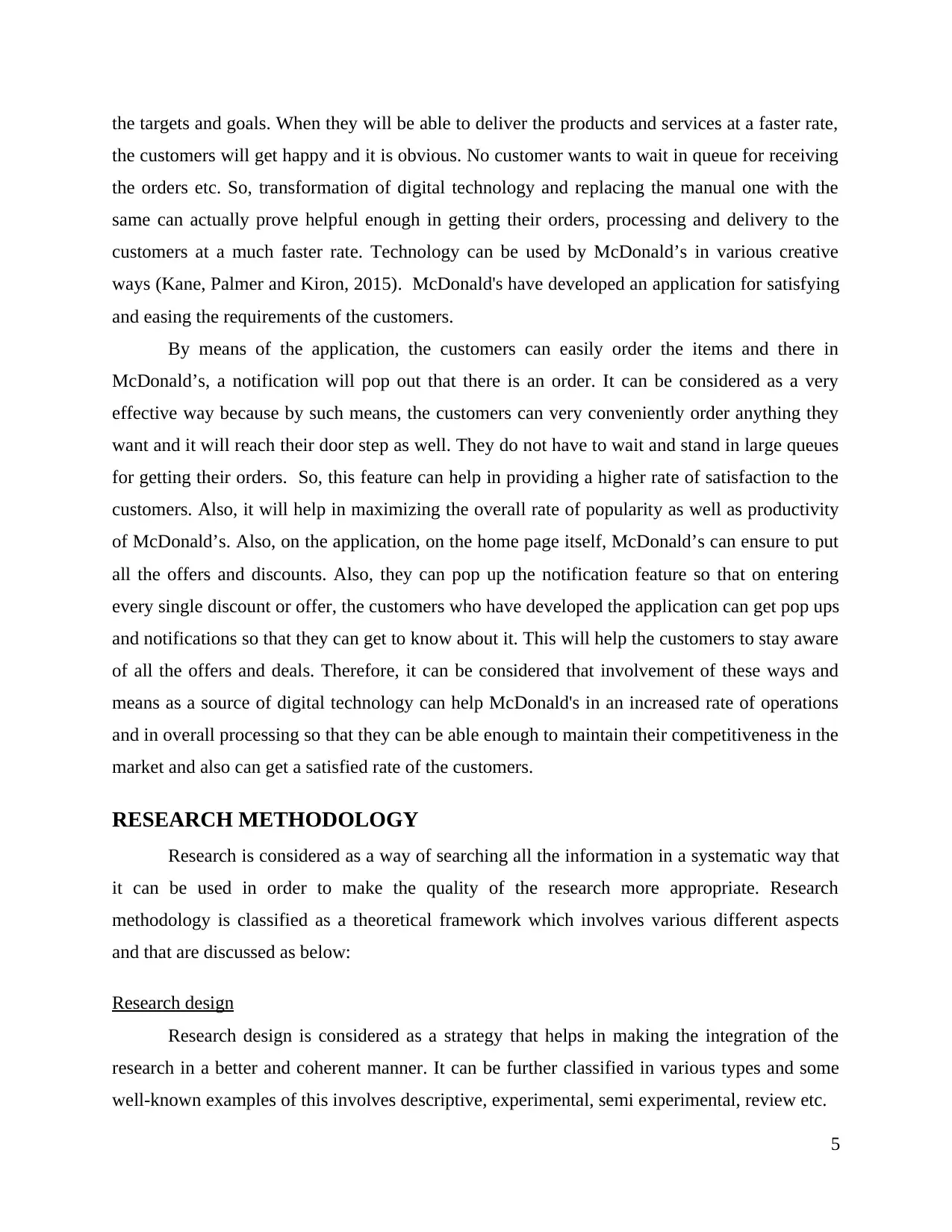
the targets and goals. When they will be able to deliver the products and services at a faster rate,
the customers will get happy and it is obvious. No customer wants to wait in queue for receiving
the orders etc. So, transformation of digital technology and replacing the manual one with the
same can actually prove helpful enough in getting their orders, processing and delivery to the
customers at a much faster rate. Technology can be used by McDonald’s in various creative
ways (Kane, Palmer and Kiron, 2015). McDonald's have developed an application for satisfying
and easing the requirements of the customers.
By means of the application, the customers can easily order the items and there in
McDonald’s, a notification will pop out that there is an order. It can be considered as a very
effective way because by such means, the customers can very conveniently order anything they
want and it will reach their door step as well. They do not have to wait and stand in large queues
for getting their orders. So, this feature can help in providing a higher rate of satisfaction to the
customers. Also, it will help in maximizing the overall rate of popularity as well as productivity
of McDonald’s. Also, on the application, on the home page itself, McDonald’s can ensure to put
all the offers and discounts. Also, they can pop up the notification feature so that on entering
every single discount or offer, the customers who have developed the application can get pop ups
and notifications so that they can get to know about it. This will help the customers to stay aware
of all the offers and deals. Therefore, it can be considered that involvement of these ways and
means as a source of digital technology can help McDonald's in an increased rate of operations
and in overall processing so that they can be able enough to maintain their competitiveness in the
market and also can get a satisfied rate of the customers.
RESEARCH METHODOLOGY
Research is considered as a way of searching all the information in a systematic way that
it can be used in order to make the quality of the research more appropriate. Research
methodology is classified as a theoretical framework which involves various different aspects
and that are discussed as below:
Research design
Research design is considered as a strategy that helps in making the integration of the
research in a better and coherent manner. It can be further classified in various types and some
well-known examples of this involves descriptive, experimental, semi experimental, review etc.
5
the customers will get happy and it is obvious. No customer wants to wait in queue for receiving
the orders etc. So, transformation of digital technology and replacing the manual one with the
same can actually prove helpful enough in getting their orders, processing and delivery to the
customers at a much faster rate. Technology can be used by McDonald’s in various creative
ways (Kane, Palmer and Kiron, 2015). McDonald's have developed an application for satisfying
and easing the requirements of the customers.
By means of the application, the customers can easily order the items and there in
McDonald’s, a notification will pop out that there is an order. It can be considered as a very
effective way because by such means, the customers can very conveniently order anything they
want and it will reach their door step as well. They do not have to wait and stand in large queues
for getting their orders. So, this feature can help in providing a higher rate of satisfaction to the
customers. Also, it will help in maximizing the overall rate of popularity as well as productivity
of McDonald’s. Also, on the application, on the home page itself, McDonald’s can ensure to put
all the offers and discounts. Also, they can pop up the notification feature so that on entering
every single discount or offer, the customers who have developed the application can get pop ups
and notifications so that they can get to know about it. This will help the customers to stay aware
of all the offers and deals. Therefore, it can be considered that involvement of these ways and
means as a source of digital technology can help McDonald's in an increased rate of operations
and in overall processing so that they can be able enough to maintain their competitiveness in the
market and also can get a satisfied rate of the customers.
RESEARCH METHODOLOGY
Research is considered as a way of searching all the information in a systematic way that
it can be used in order to make the quality of the research more appropriate. Research
methodology is classified as a theoretical framework which involves various different aspects
and that are discussed as below:
Research design
Research design is considered as a strategy that helps in making the integration of the
research in a better and coherent manner. It can be further classified in various types and some
well-known examples of this involves descriptive, experimental, semi experimental, review etc.
5
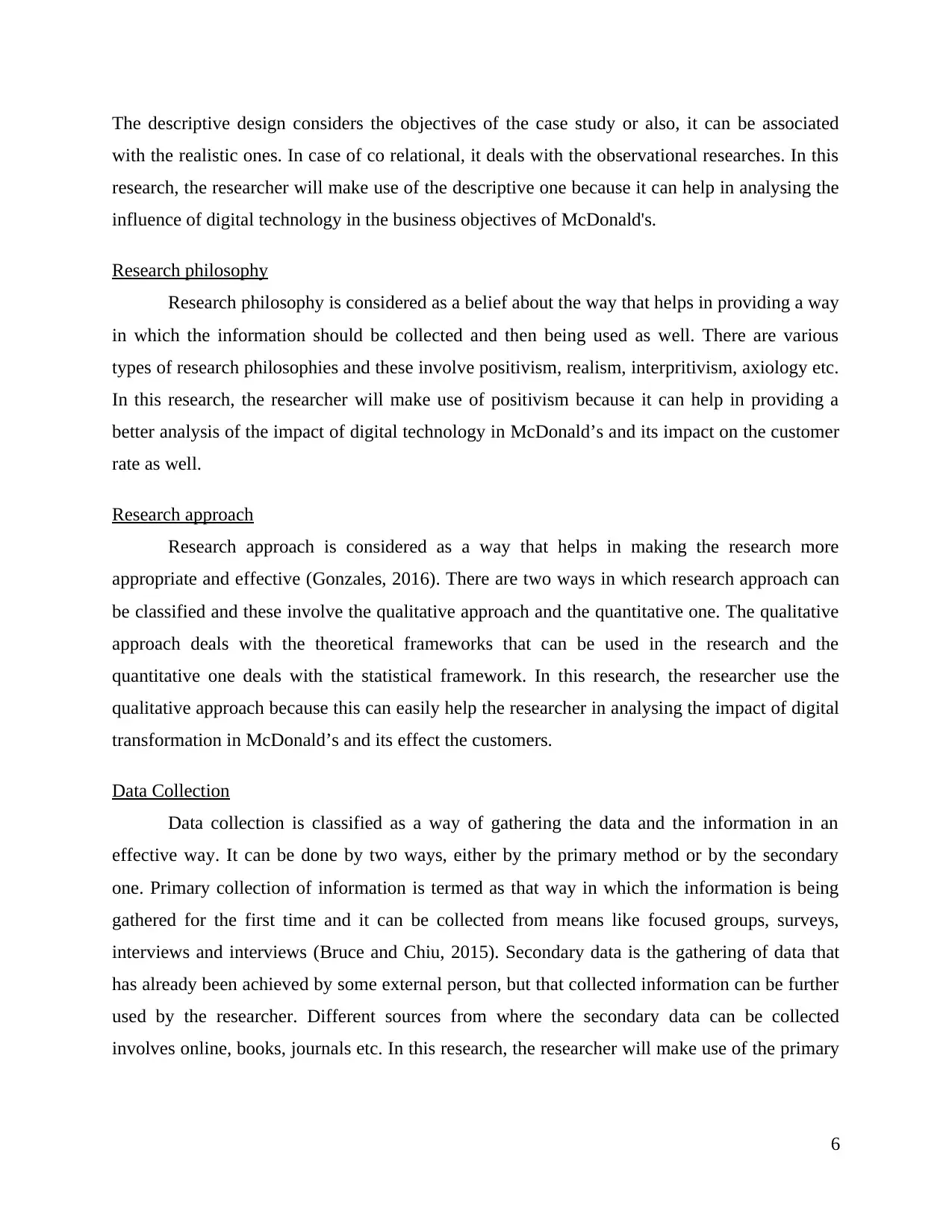
The descriptive design considers the objectives of the case study or also, it can be associated
with the realistic ones. In case of co relational, it deals with the observational researches. In this
research, the researcher will make use of the descriptive one because it can help in analysing the
influence of digital technology in the business objectives of McDonald's.
Research philosophy
Research philosophy is considered as a belief about the way that helps in providing a way
in which the information should be collected and then being used as well. There are various
types of research philosophies and these involve positivism, realism, interpritivism, axiology etc.
In this research, the researcher will make use of positivism because it can help in providing a
better analysis of the impact of digital technology in McDonald’s and its impact on the customer
rate as well.
Research approach
Research approach is considered as a way that helps in making the research more
appropriate and effective (Gonzales, 2016). There are two ways in which research approach can
be classified and these involve the qualitative approach and the quantitative one. The qualitative
approach deals with the theoretical frameworks that can be used in the research and the
quantitative one deals with the statistical framework. In this research, the researcher use the
qualitative approach because this can easily help the researcher in analysing the impact of digital
transformation in McDonald’s and its effect the customers.
Data Collection
Data collection is classified as a way of gathering the data and the information in an
effective way. It can be done by two ways, either by the primary method or by the secondary
one. Primary collection of information is termed as that way in which the information is being
gathered for the first time and it can be collected from means like focused groups, surveys,
interviews and interviews (Bruce and Chiu, 2015). Secondary data is the gathering of data that
has already been achieved by some external person, but that collected information can be further
used by the researcher. Different sources from where the secondary data can be collected
involves online, books, journals etc. In this research, the researcher will make use of the primary
6
with the realistic ones. In case of co relational, it deals with the observational researches. In this
research, the researcher will make use of the descriptive one because it can help in analysing the
influence of digital technology in the business objectives of McDonald's.
Research philosophy
Research philosophy is considered as a belief about the way that helps in providing a way
in which the information should be collected and then being used as well. There are various
types of research philosophies and these involve positivism, realism, interpritivism, axiology etc.
In this research, the researcher will make use of positivism because it can help in providing a
better analysis of the impact of digital technology in McDonald’s and its impact on the customer
rate as well.
Research approach
Research approach is considered as a way that helps in making the research more
appropriate and effective (Gonzales, 2016). There are two ways in which research approach can
be classified and these involve the qualitative approach and the quantitative one. The qualitative
approach deals with the theoretical frameworks that can be used in the research and the
quantitative one deals with the statistical framework. In this research, the researcher use the
qualitative approach because this can easily help the researcher in analysing the impact of digital
transformation in McDonald’s and its effect the customers.
Data Collection
Data collection is classified as a way of gathering the data and the information in an
effective way. It can be done by two ways, either by the primary method or by the secondary
one. Primary collection of information is termed as that way in which the information is being
gathered for the first time and it can be collected from means like focused groups, surveys,
interviews and interviews (Bruce and Chiu, 2015). Secondary data is the gathering of data that
has already been achieved by some external person, but that collected information can be further
used by the researcher. Different sources from where the secondary data can be collected
involves online, books, journals etc. In this research, the researcher will make use of the primary
6
⊘ This is a preview!⊘
Do you want full access?
Subscribe today to unlock all pages.

Trusted by 1+ million students worldwide
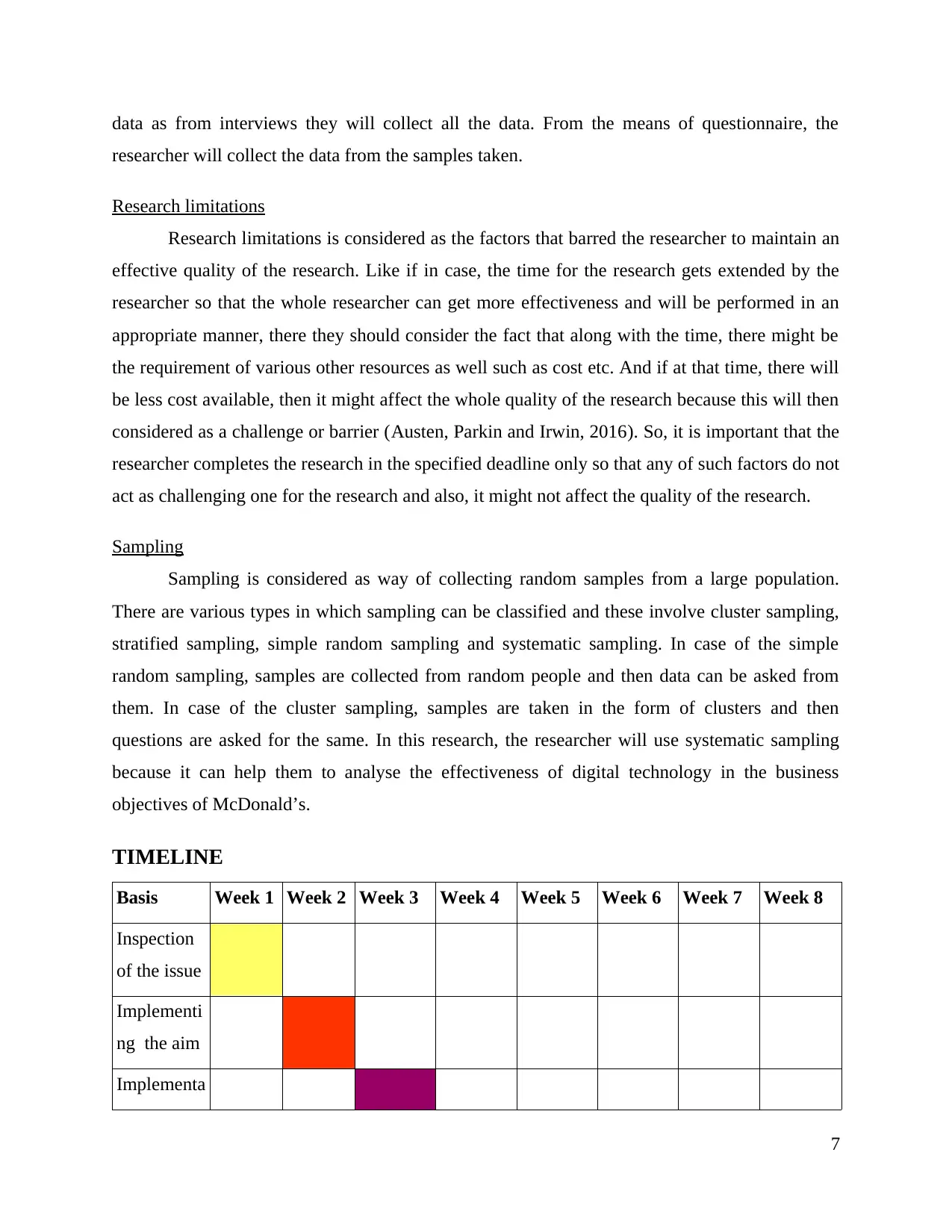
data as from interviews they will collect all the data. From the means of questionnaire, the
researcher will collect the data from the samples taken.
Research limitations
Research limitations is considered as the factors that barred the researcher to maintain an
effective quality of the research. Like if in case, the time for the research gets extended by the
researcher so that the whole researcher can get more effectiveness and will be performed in an
appropriate manner, there they should consider the fact that along with the time, there might be
the requirement of various other resources as well such as cost etc. And if at that time, there will
be less cost available, then it might affect the whole quality of the research because this will then
considered as a challenge or barrier (Austen, Parkin and Irwin, 2016). So, it is important that the
researcher completes the research in the specified deadline only so that any of such factors do not
act as challenging one for the research and also, it might not affect the quality of the research.
Sampling
Sampling is considered as way of collecting random samples from a large population.
There are various types in which sampling can be classified and these involve cluster sampling,
stratified sampling, simple random sampling and systematic sampling. In case of the simple
random sampling, samples are collected from random people and then data can be asked from
them. In case of the cluster sampling, samples are taken in the form of clusters and then
questions are asked for the same. In this research, the researcher will use systematic sampling
because it can help them to analyse the effectiveness of digital technology in the business
objectives of McDonald’s.
TIMELINE
Basis Week 1 Week 2 Week 3 Week 4 Week 5 Week 6 Week 7 Week 8
Inspection
of the issue
Implementi
ng the aim
Implementa
7
researcher will collect the data from the samples taken.
Research limitations
Research limitations is considered as the factors that barred the researcher to maintain an
effective quality of the research. Like if in case, the time for the research gets extended by the
researcher so that the whole researcher can get more effectiveness and will be performed in an
appropriate manner, there they should consider the fact that along with the time, there might be
the requirement of various other resources as well such as cost etc. And if at that time, there will
be less cost available, then it might affect the whole quality of the research because this will then
considered as a challenge or barrier (Austen, Parkin and Irwin, 2016). So, it is important that the
researcher completes the research in the specified deadline only so that any of such factors do not
act as challenging one for the research and also, it might not affect the quality of the research.
Sampling
Sampling is considered as way of collecting random samples from a large population.
There are various types in which sampling can be classified and these involve cluster sampling,
stratified sampling, simple random sampling and systematic sampling. In case of the simple
random sampling, samples are collected from random people and then data can be asked from
them. In case of the cluster sampling, samples are taken in the form of clusters and then
questions are asked for the same. In this research, the researcher will use systematic sampling
because it can help them to analyse the effectiveness of digital technology in the business
objectives of McDonald’s.
TIMELINE
Basis Week 1 Week 2 Week 3 Week 4 Week 5 Week 6 Week 7 Week 8
Inspection
of the issue
Implementi
ng the aim
Implementa
7
Paraphrase This Document
Need a fresh take? Get an instant paraphrase of this document with our AI Paraphraser
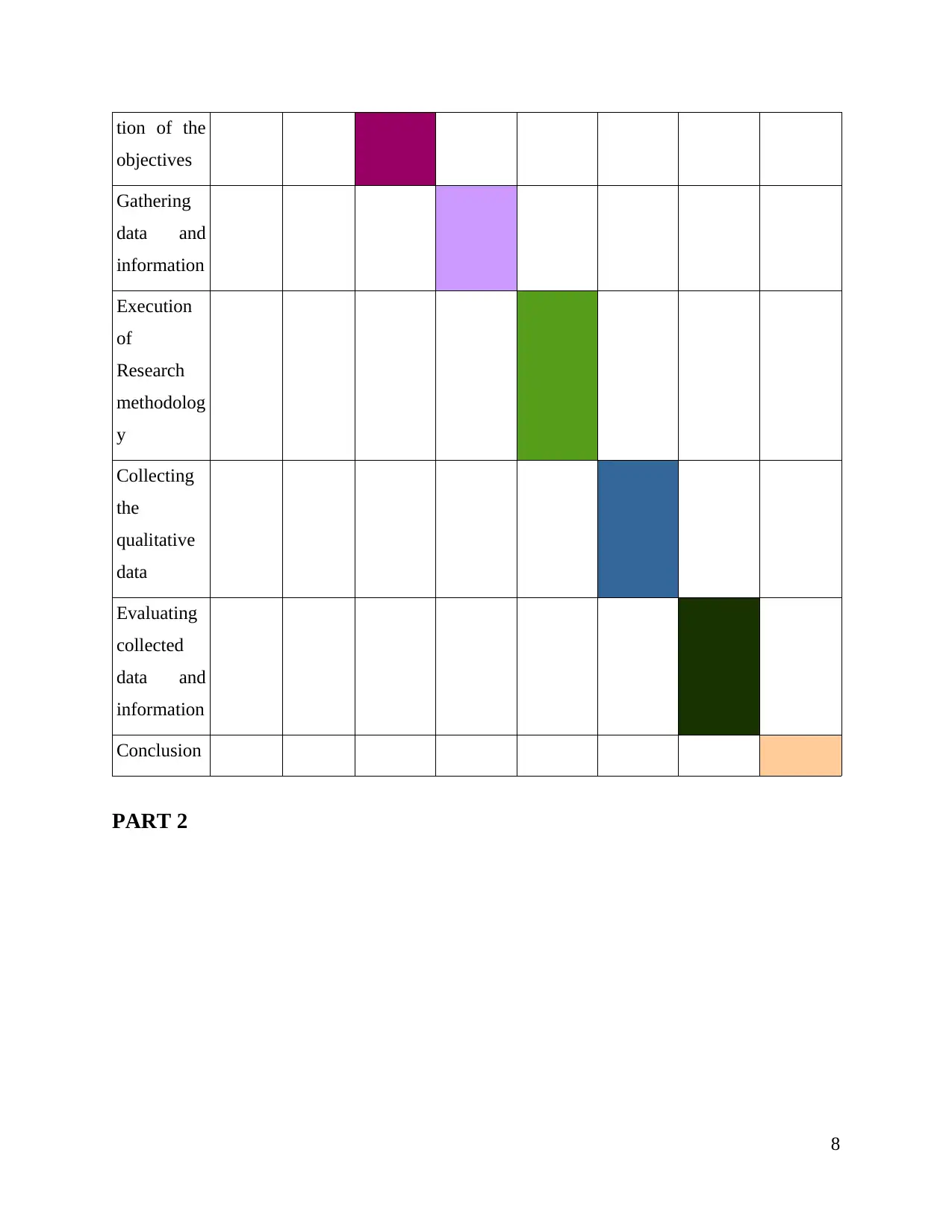
tion of the
objectives
Gathering
data and
information
Execution
of
Research
methodolog
y
Collecting
the
qualitative
data
Evaluating
collected
data and
information
Conclusion
PART 2
8
objectives
Gathering
data and
information
Execution
of
Research
methodolog
y
Collecting
the
qualitative
data
Evaluating
collected
data and
information
Conclusion
PART 2
8
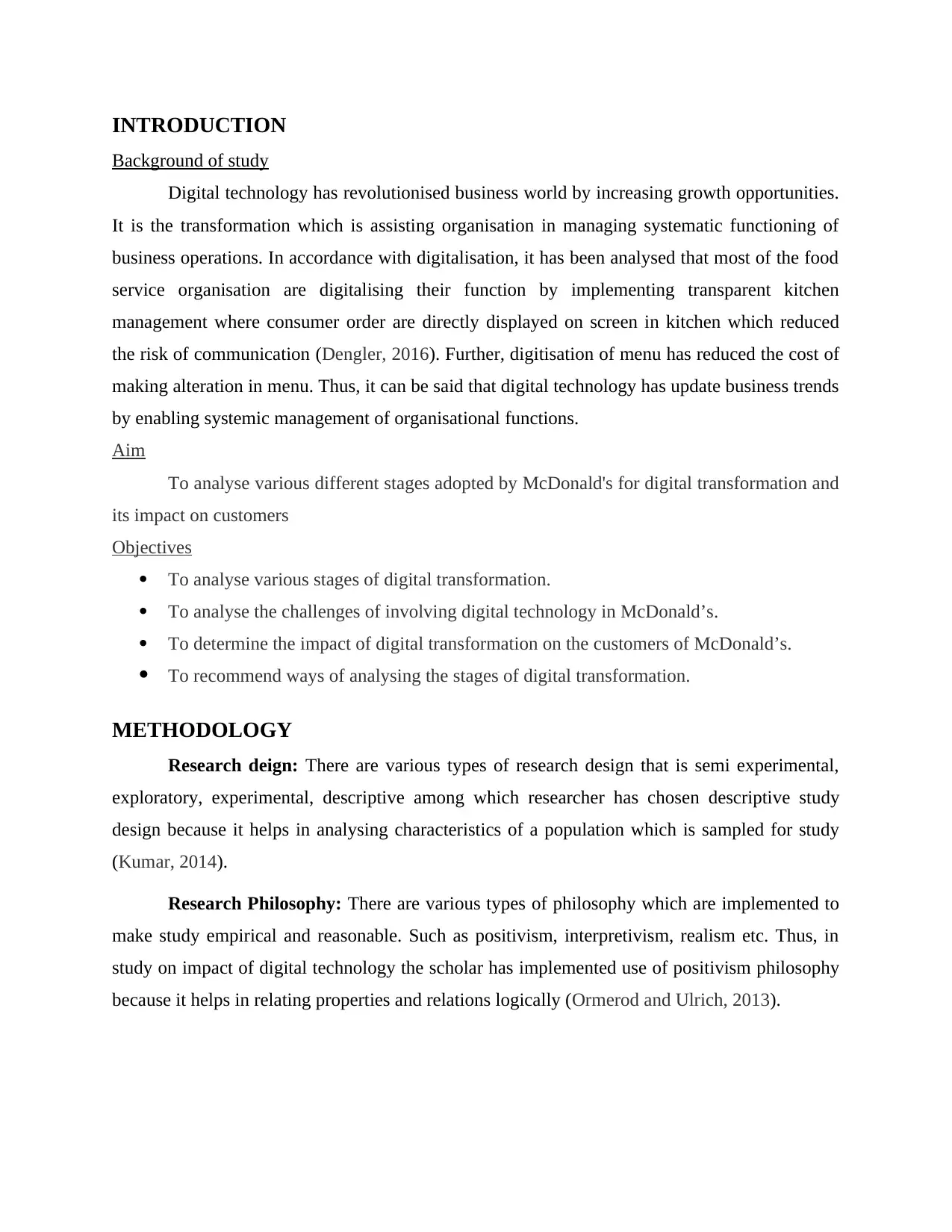
INTRODUCTION
Background of study
Digital technology has revolutionised business world by increasing growth opportunities.
It is the transformation which is assisting organisation in managing systematic functioning of
business operations. In accordance with digitalisation, it has been analysed that most of the food
service organisation are digitalising their function by implementing transparent kitchen
management where consumer order are directly displayed on screen in kitchen which reduced
the risk of communication (Dengler, 2016). Further, digitisation of menu has reduced the cost of
making alteration in menu. Thus, it can be said that digital technology has update business trends
by enabling systemic management of organisational functions.
Aim
To analyse various different stages adopted by McDonald's for digital transformation and
its impact on customers
Objectives
To analyse various stages of digital transformation.
To analyse the challenges of involving digital technology in McDonald’s.
To determine the impact of digital transformation on the customers of McDonald’s.
To recommend ways of analysing the stages of digital transformation.
METHODOLOGY
Research deign: There are various types of research design that is semi experimental,
exploratory, experimental, descriptive among which researcher has chosen descriptive study
design because it helps in analysing characteristics of a population which is sampled for study
(Kumar, 2014).
Research Philosophy: There are various types of philosophy which are implemented to
make study empirical and reasonable. Such as positivism, interpretivism, realism etc. Thus, in
study on impact of digital technology the scholar has implemented use of positivism philosophy
because it helps in relating properties and relations logically (Ormerod and Ulrich, 2013).
Background of study
Digital technology has revolutionised business world by increasing growth opportunities.
It is the transformation which is assisting organisation in managing systematic functioning of
business operations. In accordance with digitalisation, it has been analysed that most of the food
service organisation are digitalising their function by implementing transparent kitchen
management where consumer order are directly displayed on screen in kitchen which reduced
the risk of communication (Dengler, 2016). Further, digitisation of menu has reduced the cost of
making alteration in menu. Thus, it can be said that digital technology has update business trends
by enabling systemic management of organisational functions.
Aim
To analyse various different stages adopted by McDonald's for digital transformation and
its impact on customers
Objectives
To analyse various stages of digital transformation.
To analyse the challenges of involving digital technology in McDonald’s.
To determine the impact of digital transformation on the customers of McDonald’s.
To recommend ways of analysing the stages of digital transformation.
METHODOLOGY
Research deign: There are various types of research design that is semi experimental,
exploratory, experimental, descriptive among which researcher has chosen descriptive study
design because it helps in analysing characteristics of a population which is sampled for study
(Kumar, 2014).
Research Philosophy: There are various types of philosophy which are implemented to
make study empirical and reasonable. Such as positivism, interpretivism, realism etc. Thus, in
study on impact of digital technology the scholar has implemented use of positivism philosophy
because it helps in relating properties and relations logically (Ormerod and Ulrich, 2013).
⊘ This is a preview!⊘
Do you want full access?
Subscribe today to unlock all pages.

Trusted by 1+ million students worldwide
1 out of 28
Related Documents
Your All-in-One AI-Powered Toolkit for Academic Success.
+13062052269
info@desklib.com
Available 24*7 on WhatsApp / Email
![[object Object]](/_next/static/media/star-bottom.7253800d.svg)
Unlock your academic potential
Copyright © 2020–2025 A2Z Services. All Rights Reserved. Developed and managed by ZUCOL.




